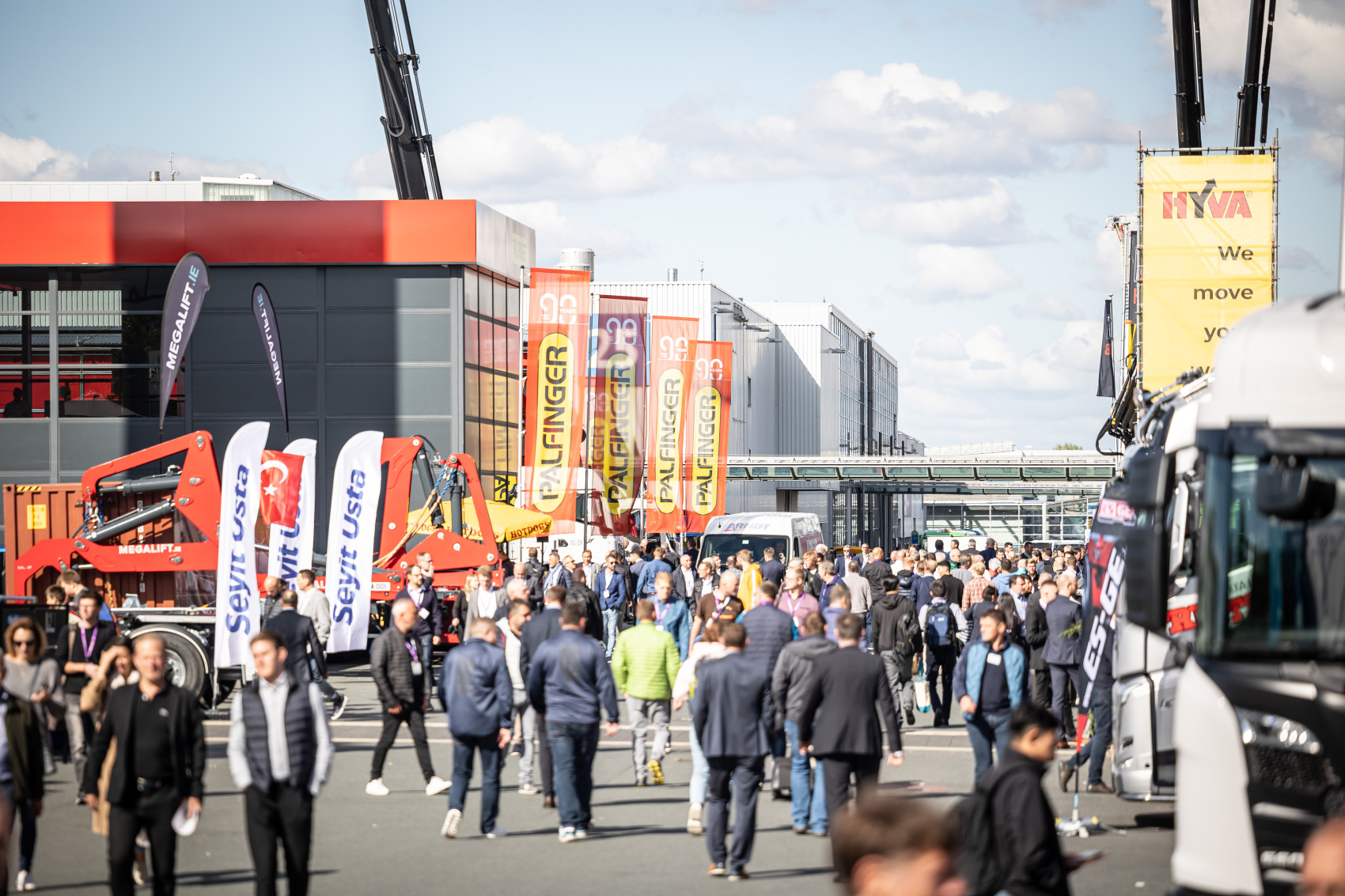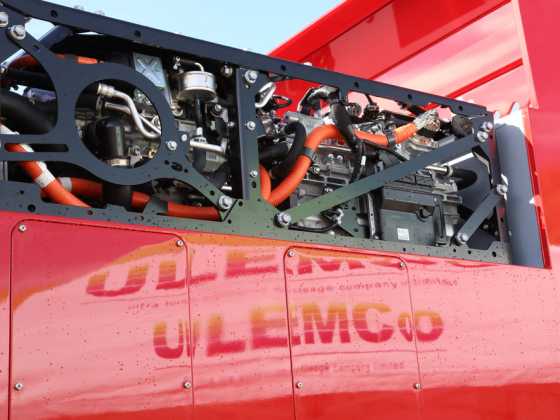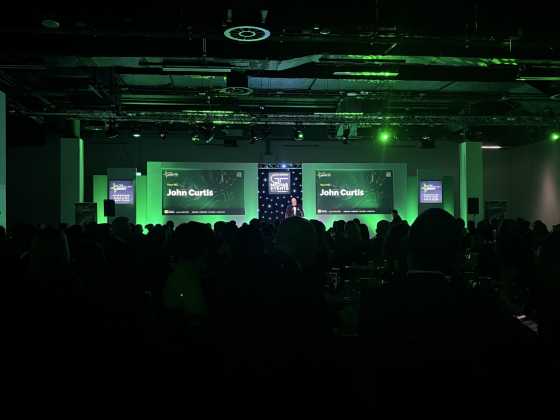Clean innovation showcased at IAA Transportation

Zero-emission innovations for commercial vehicles were unveiled at IAA Transportation, which took place between 20-25 September in Hanover, Germany. We take a look at some of the electric and hydrogen fuelled models on show
IAA Transportation took place between 20-25 September in Hanover, Germany, and showcased vehicles from the entire transport and logistics industry – from trucks to cargo bikes, delivery vans and parcel drones.
The event had a major focus on sustainability, with many of vehicle debuts electric or hydrogen-fuelled.
Hildegard Müller, president of VDA, the German Association of the Automotive Industry said: “The industry is resolutely driving forward the biggest transformation in its history and is thus making an important contribution to solving the challenges facing society. The transport and logistics industry is now taking innovation to the road – the climate neutrality mission is in full swing.”
Electric vans
IVECO unveiled its new zero-emission eDAILY, which offers up to 20m3 cargo volume, up to 4.6t payload and up to 3.5t towing ability.
Performance is in line with the ICE version: 140kW (190CV) max power, 400Nm max torque and up to 120km/h maximum speed.
The eDAILY offers as much range as required: modular battery installation allows customers to choose the level of range that best suits their mission. The configuration can be upgraded throughout the vehicle’s life.
When extra-power is needed, an additional boost can be given by activating eDAILY’s distinctive Hi-Power function. Energy use can be optimised thanks to the Driving Mode Selector – which allows either to extract maximum power or minimise power absorption. eDAILY’s One-Pedal Drive mode makes driving easier and converts brake kinetic energy into electricity, thus reducing energy consumption and brake pads wear.
eDAILY is fully connected and enables the optimisation of range, drivability and uptime – as well as remote control of charging operations and internal climate. Pre-conditioning brings the vehicle to the ideal cabin temperature while it is still connected to the charging socket.
eDAILY is offered in van, cab, crew cab, chassis cowl and minibus body variants from 3.5 to 7.2 GVW, in singlewheel and twin-wheel versions, with a broad range of height and wheelbase options.
eDAILY can be equipped with up to three batteries. The FPT Industrial / Microvast 37kWh modular battery packs account top-level energy density (265Wh/kg at cell level) and best-in-class usable energy at 95 per cent. They are protected by 8-year and up to 250,000km battery warranty including replacement when capacity drops below 80%.
Charging options include fast charging at 80kW, which adds up to 100km of range in just 30 minutes. Charging can be fully managed via the dedicated app. The eDAILY front charging port is easily accessible no matter what direction the cable is coming from. Behind the sliding flap which protects the plug from water and dust, an LED indicator shows the status and level of charge at a glance.
At the IAA, IVECO and refrigerated vehicle rental and leasing company Petit Forestier Group, announced the signature of a Memorandum of Understanding for the supply of 2,000 eDAILY chassis cabs, with delivery of the first 200 planned for 2023. The vehicles will be fitted with refrigerated bodies by bodybuilder Lecapitaine, a wholly owned subsidiary of Petit Forestier. The eDAILY refrigerated vehicles will join Petit Forestier’s extensive rental fleet.
Electric innovation
SAIC MAXUS showcased five of its electric vehicles at IAA Transportation – the eDELIVER 3 and eDELIVER 9, the MAXUS MIFA 9, the T90 EV electric pickup, as well as SAIC’s latest project, the MAXUS Electric Light Truck.
The MIFA 9 MPV offers a range of up to 369 miles on a single charge. With a body size of 5,270 x 2,000 x 1,840mm, the seven-seater model on display was a high spec vehicle boasting intelligent driving housekeeper, which automatically recognises driving style through data and scene driving. MIFA 9 is available to order now, with delivery in Q1 2023.
MAXUS’ new electric pick up, T90 EV, has a battery pack of 88.5kwh and is designed for both on and off-road driving. It’s equipped with a high-level spec and a contemporary and stylish interior. With a range of 205 miles and a payload of 1 tonne, the visually sporty exterior is complemented by a modern interior with a 10.25-inch digital touch screen instrument cluster providing a minimalist look. The T90EV is roomy thanks to a neat dashboard design and floor console, making more room for both occupants and storage.
Also making its European debut was MAXUS’ all-new Electric Light Truck with a driving range of up to 132 miles (full load comprehensive condition). The currently named EH300 Electric Light Truck features a three-seater single cabin, with a GVW of 7490Kg.
With a 127.74KWH CATL Lithium battery onboard, the vehicle will have a maximum speed of 90km/h, a peak power of 60/110Kw and a peak torque of 635/1200Nm. The new MAXUS vehicle will also have a maximum charging power of 102Kw for a DC charge and a 22Kw for an AC charge. Charging times will vary, with a DC charge taking 1.5 hours and an AC charge taking 11 hours.
Also on show was the eDELIVER 3, which was designed from the ground-up for electric power only with a 50.23Kwh battery. It is a small van that can clock up to 228/238 km (WLTP combined) on a single charge. The eDELIVER 3 boasts 90KW motor with peak power of 40/90kW and a max torque of 125/255 N.m. Available in a number of variants and wheelbase options, the e DELIVER 3 is a versatile vehicle that suits a wide range of business needs.
The eDELIVER 9 is available in two size options and with three battery options. Through various battery cooling methods, the eDELIVER 9 offers a reduced charging time (DC 36-45mins 20% - 80%, as well as extend battery life and increased operating range.
Renault’s Trafic Van E-Tech Electric
Renault unveiled its Trafic Van E-Tech Electric, which has all the same qualities as the ICE model, with new safety features, a modern multimedia system, and a bigger and better range of engines.
The Trafic Van E-TECH Electric has either 5.08m or 5.48m long and 1.967m or 2.498m high, its load volume ranges from 5.8m3 to 8.9m3, and the load length can extend up to 4.15m (on the extended L2 version featuring the ‘through load’ bulkhead).
The Trafic Van E-TECH Electric comes with a 90kW motor with a 750kg towing capacity and can carry up to 1.1 tonne.
The 52kW battery has a range of 149 miles WLTP. To recharge the battery, the vehicle offers the choice between three types of chargers: a single-phase 7kW AC charger, suitable for all types of domestic charging; a 22kW AC charger for rapid charging at public charging stations; and an optional 50kW DC charger for fast charging on motorways.
Electric and hydrogen fuel cell HGVs
Iveco and Nikola Corporation launched two new zero emission heavy duty trucks at IAA 2022; the Nikola Tre battery-electric vehicle, and the Nikola Tre fuel cell electric vehicle.
The Nikola Tre BEV Artic 4x2 has a wheelbase of 4.021 mm, features nine batteries with a total energy storage up to 738 kWh, which delivers a range of approximately 310 miles. Charging takes around 162 minutes, with a 175 kW charger. Charging up to 350 kW is expected later this year. With a total 738 kWh of energy and the 480 kW continuous power of the FPT Industrial e-Axle, it has the power, torque and range to perform applications such as hub to-hub deliveries and regional haulage – and its mileage can be extended with opportunity charging.
The Nikola Tre FCEV Artic 6x2 has a wheelbase of 3.932 mm, and can accommodate approximately 70 usable kilograms of hydrogen at 700-bar pressure. This capacity, together with its fast-refuelling time of just under 20 minutes, enables a range of up to 497 miles. The Nikola Tre FCEV is expected to enter the European market in 2024.
The Nikola Tre platform is based on the IVECO S-WAY truck and features an electric axle co-designed and produced by FPT Industrial, and Nikola’s advanced electric technology. The IVECO and Nikola teams adopted a modular approach to this platform so that it’s capable of hosting both battery and fuel-cell propulsion technologies.
Zero emission HGVs
Mercedes-Benz Trucks allowed visitors to see its eActros LongHaul for the first time at the IAA Transportation, which has a range of around 310 miles from a single charge.
Three battery packs provide an installed total capacity of over 600 kWh. Two electric motors, as part of a new e-axle, generate a continuous output of 400 kW (536 hp) and a peak output of over 600 kW (805 hp). In addition to the tractor unit, Mercedes-Benz Trucks will also produce rigid variants of the eActros LongHaul at market launch.
QUANTRON meanwhile presented a number of zero-emission commercial vehicles which are based on two self-developed hydrogen and battery-electric platforms.
The QUANTRON QHM FCEV is a hydrogen FCEV heavy duty truck, which it created together with hydrogen experts Ballard Power Systems. It uses state-of-the-art components, including the FCmove™-XD 120 kW fuel cell newly developed by Ballard and the integrated eGen Power® 130D E-axle from Allison Transmission. In addition, QUANTRON offers an optionally available aero package for all QHM FCEV trucks which has been designed to improve the operating range by a further 10 per cent.
As a tractor unit for heavy long-distance transport, the QUANTRON QHM FCEV 44-1000 has a range of around 435 miles, depending on the load and topographical requirements. It has a hydrogen tank of about 54 kg fully integrated in the chassis. What’s more, it has optimised H2 consumption through specially developed intelligent Q-ENERGY management system.
QUANTRON also unveiled its all-electric heavy-duty truck platform, QHM BEV, which is available as a 44-400 tractor unit as well as the 27-400 chassis in a large number of variants.
The up to 392 kWh high-voltage battery can be re-charged to provide a performance of up to 350 kW DC has an operating range of up to 218 miles, depending on weight and topographical requirements.
QUANTRON also presented a light truck equipped with a Ballard Power hydrogen fuel cell drive that has an operating range of up to 310 miles, called the QUANTRON QLI FCEV. This is now available to order in the 4.2 to 7.2 tonne class. The quiet and emission-free transporter can be used flexibly and for a wide range of applications thanks to its different body variants, in particular for longer distance tours but also for the last mile.
On the VanSelect partner stand, the all-electric QUANTRON QLI BEV transporter of 3.5 to 7.2 tonnes was on display. As a 3.5 t lightweight variant, it is designed to accommodate payloads of up to 1,000 kg (depending on the body).
QUANTRON also showcased its all-electric bus CIZARIS 12 EV, which has a range of up to 230 miles.
FUSO’s next generation eCanter
Fuso has unveiled its new eCanter, which has been enhanced to further meet customer requirements.
The eCanter was first introduced in 2017 and there are more than 450 FUSO eCanters in daily customer operation in Europe, Japan and the United States, as well as in Australia and New Zealand.
While the current electric truck was previously only available as a 7.49-tonner with a wheelbase of 3,400 millimetres, customers now have a choice of six wheelbases between 2,500 and 4,750 millimetres and a permissible gross vehicle weight of 4.25 to 8.55 tonnes. The load capacity of the chassis is up to 5.0 tonnes. The Next Generation eCanter is powered either by a 110 kW (150 hp) electric motor in variants with gross weights of 4.25 and 6.0 tonnes, or a 129 kW (180 hp) electric motor in variants with gross weights of 7.49 and 8.55 tonnes. This optimised driveline delivers 430 Nm of torque; the maximum speed is 89 km/h.
Depending on the wheelbase, three different battery packs are available: S, M and L. The batteries use lithium iron phosphate (LFP) cell technology. These are characterised above all by a long service life and more usable energy. The battery pack in the S variant has a nominal capacity of 41 kWh and enables a range of up to 43 miles. In the M variant, the nominal capacity is 83 kWh and the range is up to 87 miles. The L variant, as the most powerful package, offers a nominal capacity of 124 kWh and a range of up to 124 miles. This is far more than the distance usually covered per day in light distribution traffic. Recuperation can increase the range even further, which at the same time minimises charging breaks. By comparison: Until now, the eCanter only had a battery option with a nominal capacity of 81kWh and a range of up to 100 kilometres.
As far as battery charging is concerned, the eCanter is compatible with all main voltages in the major markets. The charging unit supports charging with both alternating current (AC) and direct current (DC). The Combined Charging System CCS is the charging standard, and charging is possible with up to 104 kW. DC fast charging to 90 per cent of capacity is possible in approximately 36 minutes (S), 44 minutes (M) and 75 minutes (L), depending on the battery pack. AC charging (11kW and 22 kW) takes between four and six hours, depending on the battery pack.






